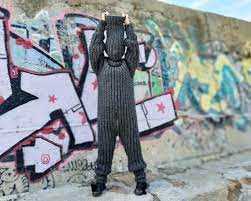Yarn bombing is a form of urban art that originated in the early 2000s and has gained popularity around the world. It started as a way for knitters, who were often discouraged from displaying their work in galleries, to bring their creations out into the public eye. Rather than simply hanging their knitted pieces on walls, these artists began to wrap them around trees, lampposts, and other structures, creating a unique and eye-catching display.
One of the main appeals of knitted wool street art is its temporary nature. Yarn bombs can be easily removed without causing any damage, making it a non-destructive form of artistic expression. This allows artists to freely adorn public spaces without fear of legal repercussions. Additionally, the use of soft, tactile materials like wool adds a sense of warmth and comfort to the typically cold and impersonal urban environment.
Knitted wool street art is a form of urban intervention that challenges the traditional boundaries of art. It brings color, texture, and a sense of playfulness to the streets, engaging and delighting passersby. Whether it’s a lamppost cozily wrapped in a colorful scarf or a tree adorned with a knitted sweater, these unexpected installations bring art to the masses and remind us that creativity can be found in the most unlikely places.
The origins of knitted wool street art can be traced back to the early 2000s. Some sources credit Magda Sayeg, a textile artist from Texas, as one of the pioneers of this art form. Sayeg, inspired by a desire to add some color and warmth to the cold and impersonal city environment, began by covering a door handle in her hometown with a knitted cozy. The response was overwhelmingly positive, which led Sayeg to continue yarn bombing various objects around the city.
The trend quickly spread across the globe, with knitted wool street art appearing in major cities such as New York, London, and Berlin. Communities of knitters formed, collaborating on large-scale projects to cover entire buildings, statues, or park benches with knitted or crocheted designs. This grassroots movement democratized the art world and brought joy and beauty to urban landscapes.
The Impact of Knitted Wool Street Art
Knitted wool street art challenges traditional notions of art and invites a new level of interaction and engagement with the public. Unlike traditional graffiti, which is often associated with vandalism and illicit activity, yarn bombing is non-destructive and often receives the support and permission of local authorities. This allows knitters to display their creativity and make a positive impact on their communities.
In addition to brightening up public spaces, knitted wool street art sparks conversations and creates a sense of shared ownership and pride. The temporary nature of the installations adds an element of surprise and delight, as the pieces may suddenly appear overnight, transforming a mundane object into a work of art.
The Future of Knitted Wool Street Art
As knitted wool street art gains recognition and acceptance as a legitimate form of public art, its future looks bright. Art collectives and organizations are emerging that focus specifically on yarn bombing, hosting workshops, and exhibitions to showcase the talent and creativity of knitters.
With its ability to bring people together and brighten urban landscapes, knitted wool street art is likely to continue spreading its warmth and joy around the world.
Techniques and Materials Used in Knitted Wool Street Art
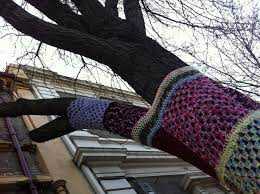
There are various techniques and materials used in knitted wool street art, each contributing to the overall aesthetic and impact of the artwork. Here are some of the commonly used techniques:
| Technique | Description |
|---|---|
| Knitting | Knitting is the most commonly used technique in knitted wool street art. It involves using two or more needles to create fabric by interlocking loops of yarn. Knitted pieces can be created in various sizes and shapes, allowing for endless possibilities in street art installations. |
| Crocheting | Crocheting is another popular technique used in yarn bombing. It involves using a single crochet hook to create fabric by pulling loops of yarn through other loops. Crocheted pieces can have more intricate designs and textures compared to knitting. |
| Weaving | Weaving is a technique that involves intertwining threads or yarns to create a textile. In knitted wool street art, weaving can be used to create large-scale installations or add details and patterns to existing knitted or crocheted pieces. |
| Felting | Felting is a technique that involves matting fibers together to create a dense and sturdy fabric. This technique is often used in knitted wool street art to create three-dimensional sculptures or add texture to flat surfaces. |
| Embroidery | Embroidery is a decorative technique that involves stitching designs onto fabric. In knitted wool street art, embroidery can be used to add additional details, patterns, or text to the knitted or crocheted pieces. |
In addition to these techniques, various materials can be used in knitted wool street art. The most common material is, of course, yarn, which comes in different colors, textures, and thicknesses. Other materials that are often incorporated into yarn bombing installations include fabric scraps, ribbons, beads, and even recycled materials such as plastic bags or old clothes.
Overall, the techniques and materials used in knitted wool street art allow artists to create eye-catching and interactive installations that bring beauty and warmth to public spaces. These artworks not only engage with the surrounding environment but also evoke a sense of joy and creativity in the viewers.
Famous Knitted Wool Street Artists

Knitted wool street art has gained popularity in recent years, and there are several artists who have become well-known for their unique creations. These individuals have brought a new dimension to street art by using knitting techniques to create colorful and eye-catching installations in public spaces.
One of the most famous knitted wool street artists is Olek, whose real name is Agata Oleksiak. She is known for her vibrant and intricate knit sculptures that often cover entire buildings or objects. Olek’s work can be seen in cities around the world, and she has been featured in numerous exhibitions and publications.
Another notable artist in this genre is Magda Sayeg, the founder of the “Knitta Please” movement. Sayeg started by yarn bombing small objects in public spaces and quickly gained recognition for her innovative use of knitting in street art. Her work has since expanded to large-scale installations and she has collaborated with major brands and organizations.
Leanne Prain is a knitted wool street artist who uses her work to explore themes of community and belonging. Prain often creates installations that involve the participation of local communities, using knitting as a way to bring people together. Her colorful and playful creations can be found in various cities.
These are just a few examples of the famous knitted wool street artists who have made a name for themselves in this unique art form. Their creativity and skill have helped to transform public spaces and bring joy and beauty to urban environments.
The Impact of Knitted Wool Street Art on Urban Spaces
One of the main impacts of knitted wool street art is its ability to transform ordinary urban spaces into vibrant and visually appealing areas. By covering objects such as lampposts, benches, and trees with colorful knitted yarn, these art installations add a sense of beauty and playfulness to the often monotonous concrete landscapes of cities.
Furthermore, knitted wool street art has the power to create a sense of community and connection among residents. By bringing together individuals of all ages and backgrounds in the creation of these art installations, it fosters a spirit of collaboration and shared ownership of the public space.
In addition to its aesthetic and community-building impacts, knitted wool street art also has an environmental advantage. The use of yarn, which is often made from natural materials such as wool or cotton, makes this form of art more sustainable compared to traditional forms of street art that use paint or other synthetic materials.
Moreover, the temporary nature of knitted wool street art allows for constant change and evolution in urban spaces. These installations can be easily removed or replaced, creating a dynamic and ever-changing visual landscape that keeps the streets alive and engaging for both residents and visitors.
The Relationship Between Knitted Wool Street Art and Graffiti
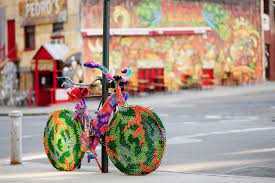
While graffiti is often associated with spray paint and tags, knitted wool street art takes a softer approach by using yarn and knitting techniques. However, both forms of art share the goal of brightening up public spaces and adding an element of surprise and intrigue to often overlooked locations.
One commonality between knitted wool street art and graffiti is their subversive nature. Both art forms challenge authority and question the boundaries of acceptable art. Knitted wool street art may not be sanctioned by the local government or arts institutions, just like graffiti. This subversive nature can lead to controversy, with both art forms facing criticism and legal challenges.
Another similarity between these art forms is the element of community involvement. Graffiti often involves collaboration between artists, and the same is true for knitted wool street art. Knitting circles or groups of artists may come together to create large-scale installations or cover specific objects, such as lampposts or trees, in knitted wool art.
Both knitted wool street art and graffiti have gained popularity in recent years, with artists pushing the boundaries of what is considered acceptable in urban art. They both offer a unique form of self-expression and provide an alternative to traditional forms of art. Whether it’s a colorful, knitted yarn bomb or a vibrant graffiti mural, both forms of art have the power to captivate and engage audiences.
Challenges and Controversies in Knitted Wool Street Art
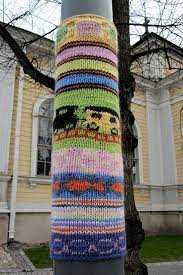
Lack of Permanent Installations
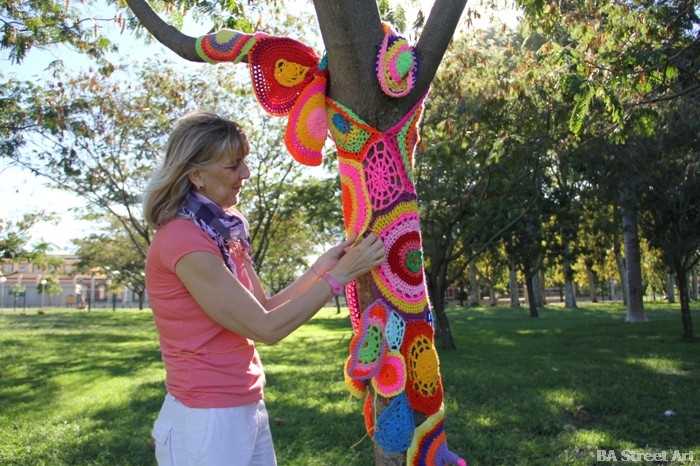
One of the challenges faced by knitted wool street art is the lack of permanent installations. Unlike traditional forms of street art, such as murals or graffiti, knitted wool art is temporary and can be easily removed or damaged. This makes it difficult for artists to leave a lasting impact on the urban landscape.
Difficulty in Obtaining Permission
Another challenge faced by knitted wool artists is obtaining permission from local authorities or property owners to display their art. Due to the temporary nature of knitted wool art and concerns about potential damage or vandalism, many authorities are hesitant to grant permission. This limits the opportunities for knitted wool artists to showcase their work in public spaces.
However, some artists have found creative ways to overcome these challenges. They often seek out public spaces where they have a higher chance of receiving permission, such as community gardens or designated art installations.
Controversies
In addition to these challenges, knitted wool street art has also been a subject of controversy.
Appropriation of Public Spaces
Some critics argue that knitted wool street art is a form of appropriation of public spaces. They contend that by decorating public property without permission, knitted wool artists are infringing upon the rights of others to use and enjoy those spaces.
Environmental Impact
Knitted wool street art often uses synthetic yarns that are not biodegradable. This raises concerns about the environmental impact of such artworks. Critics argue that by creating art with non-sustainable materials, knitted wool artists contribute to waste and pollution.
Despite these challenges and controversies, knitted wool street art continues to capture the imagination of both artists and admirers. It offers a unique way to transform public spaces and bring warmth and color to urban environments.
Knitted Wool Street Art in Different Cities Around the World
Knitted wool street art has become a popular form of urban artwork, bringing color and warmth to the streets of cities around the world. With its unique combination of craft and public art, knitted wool street art is capturing the attention of both locals and tourists.
The Roots of Knitted Wool Street Art
Global Impact of Knitted Wool Street Art
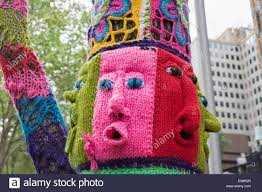
Knitted wool street art can now be seen in cities all over the world, from New York to Tokyo, London to Sydney. It adds a playful and unexpected element to the concrete jungle, transforming ordinary objects like lampposts, trees, and statues into vibrant works of art.
Not only does knitted wool street art brighten up the cityscape, but it also brings communities together. Many installations are created through collaborative efforts, with local residents and knitting enthusiasts coming together to create colorful and unique pieces. The act of creating and installing the art becomes a bonding experience, fostering a sense of community and pride.
The popularity of knitted wool street art is undeniable, with social media platforms like Instagram and Facebook showcasing the creativity and talent of artists around the world. Photos of these colorful installations often go viral, attracting attention and admiration from people of all walks of life.
The Future of Knitted Wool Street Art
As the popularity and recognition of knitted wool street art grow, we can expect to see even more creativity and innovation in this art form. Artists are experimenting with different materials, techniques, and styles to push the boundaries of what can be achieved with knitted wool.
Whether you stumble upon a knitted wool masterpiece while walking down a city street or catch a glimpse of it online, the impact of this unique form of street art is undeniable. Knitted wool street art brings joy, color, and a sense of wonder to cities around the world, reminding us that art can be found in unexpected places.
Recognizing Knitted Wool Street Art as a Form of Art
Artistic Expression and Creativity
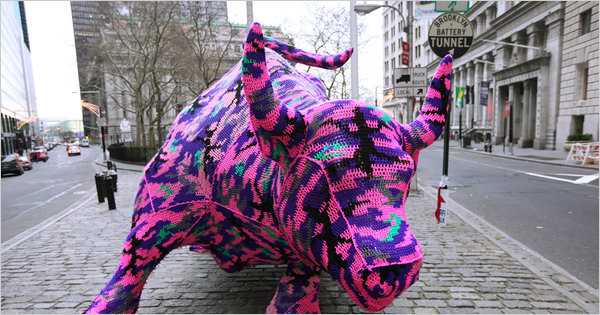
Knitted wool street art offers a platform for artists to express their creativity and showcase their skills in a public setting. The intricate and detailed designs created using yarn demonstrate the artist’s passion and dedication. Each piece is carefully crafted and represents a unique artistic expression that adds beauty and allure to the surroundings.
Furthermore, yarn bombing allows artists to think outside the traditional boundaries of art, as they are not limited to traditional canvases or galleries. By transforming everyday objects and public spaces into colorful and eye-catching works of art, knitted wool street art challenges the notion of what art can be and where it can be found.
Community Engagement and Connection
An important aspect of knitted wool street art is its ability to engage and connect with the local community. These installations often elicit joyful and positive reactions from passersby, who are surprised and delighted by the unexpected burst of color in their everyday lives. The temporary nature of yarn bombing encourages people to pause, appreciate, and even interact with the art, fostering a sense of shared experience and connection among community members.
Additionally, knitted wool street art can also serve as a form of social commentary or activism. Artists may utilize their creations to raise awareness about important social or environmental issues, sparking conversations and inspiring action within the community.
| Benefits of Recognizing Knitted Wool Street Art as Art |
|---|
| 1. Broadens the definition of art |
| 2. Encourages artistic experimentation |
| 3. Adds vibrancy and beauty to public spaces |
| 4. Fosters community engagement and connection |
| 5. Raises awareness about social issues |
The Future of Knitted Wool Street Art
Knitted wool street art has become an increasingly popular form of expression, captivating both artists and art enthusiasts around the world. With its vibrant colors and intricate designs, it adds a touch of warmth and coziness to urban landscapes.
As the art form continues to evolve, the future of knitted wool street art seems promising. Here are some exciting possibilities that lie ahead:
- Technological advancements: With the advancement of technology, artists will have access to new and innovative tools to enhance their creations. This could include creating interactive pieces that respond to touch or sound, adding a new dimension to the traditional art form.
- Sustainability: As society becomes more conscious of the environment, there is a growing demand for sustainable art practices. Knitted wool street art offers an eco-friendly alternative to traditional forms of street art that often rely on harmful chemicals and materials. In the future, we can expect to see artists integrating more sustainable practices, such as using recycled yarn or natural dyes.
- Inclusion and diversity: The beauty of knitted wool street art is its accessibility and inclusivity. Anyone can participate, regardless of age, gender, or artistic training. The future of this art form will likely see an even greater representation of diverse voices and stories, as artists continue to push boundaries and challenge societal norms.
- Collaboration: Street art has always been a collaborative art form, with artists coming together to create something greater than the sum of its parts. Knitted wool street art is no exception. In the future, we can expect to see more collaborative projects, where artists from different backgrounds and disciplines work together to create stunning installations and displays.
- Recognition and appreciation: As knitted wool street art gains more visibility and recognition, it is expected to be appreciated as a legitimate form of art. Museums and galleries may start showcasing knitted wool street art exhibitions, elevating its status in the art world and providing a platform for artists to reach a wider audience.
The future of knitted wool street art holds immense potential. As artists continue to push boundaries and experiment with new techniques, we can look forward to a more vibrant and inclusive art landscape.

I am a mural enthusiast and a fervent admirer of street art. Rather than creating murals myself, I am passionate about collecting them. My love for street art knows no bounds. I am dedicated to curating and cherishing these artworks that grace the streets. My collection stands as a testament to my profound appreciation for this form of artistic expression.
read about me

